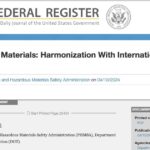The U.S. Department of Transportation’s Pipeline and Hazardous Materials Safety Administration published a new Final Rule that harmonizes federal regulations with international standards that the agency helped establish.
PHMSA says the action improves safety, streamlines the transport of essential products — including medical supplies, batteries and components used in manufacturing — and encourages shippers to package goods more efficiently.
“The safe transportation of hazardous material like batteries and components used in manufacturing is integral to our supply chains and our economy,” said U.S. Transportation Secretary Pete Buttigieg. “This new rule improves safety, keeps the U.S. competitive on the global stage, and cuts shipping costs to the benefit of consumers nationwide.”
Also Read: Illegal Lithium Battery Transport Burn Just Before Going to Sea
PHMSA says the final rule will help reduce greenhouse gas emissions and supply chain disruptions by allowing the transport of more goods in fewer trips and aligning hazardous materials regulations requirements with anticipated increases in the volume of lithium batteries transported in domestic and international commerce due to the electrification of the transportation and other economic sectors.
“This regulatory update actually improves safety and environmental benefits while reducing red tape for businesses,” said PHMSA Deputy Administrator Tristan Brown. “It will also help improve supply chains and reduce prices for everyday Americans.”
Also Read: FDNY Shares Fire, Hazmat Lessons on Lithium-Ion Batteries
Amendments to the rule include changes to proper shipping names, hazard classes, packing groups, special provisions, packaging authorizations, air transport quantity limitations, and vessel stowage requirements. These amendments are necessary to facilitate the transport of hazardous materials in domestic and international commerce.The final rule is currently available in the Federal Register.
Original post – Copyright © 2024 HazmatNation.com. Externally linked references may hold their own independent copyright not assumed by HazmatNation










